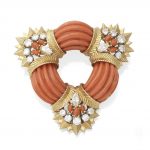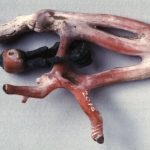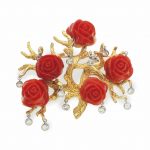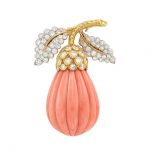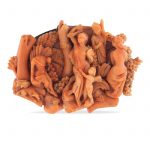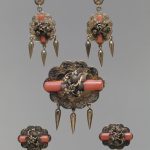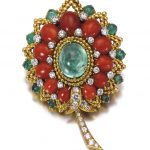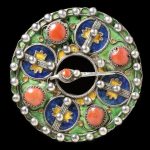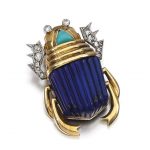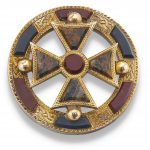Information and history of coral plus a gallery of coral used in antique and vintage brooches. Believed by classical civilizations to possess therapeutic and apotropaic powers and used as ornament since ancient times, coral was a staple of jewelry design in Victorian America. Coral is an organic gem, the skeleton of tiny marine animals called ‘polyps.’ During the mid-nineteenth century, when this demi-parure was fabricated, coral was mainly harvested from the Mediterranean waters surrounding Naples. American jewelers like Ball, Black & Co. imported Neapolitan coral and set the gems in mountings of their own design. Reference: The Metropolitan Museum of Art
A coral and diamond brooch/pendant, by Kutchinsky, 1970 Of triangular openwork form, set with three fluted coral corallium rubrum panels, accented by radiating clusters of brilliant and marquise-cut diamonds, with trios of navette-shaped coral corallium rubrum cabochons, mounted in 18 carat yellow gold, diamonds approx. 3.95cts total, signed Kutchinsky, maker’s mark KLD, London hallmark, length 5.7cm, maker’s case
Sold for £5,625 inc. premium at Bonhams in 2018
A DIAMOND, CORAL AND GOLD ‘ROSE BUSH’ PIN BY CHARLES VAILLANT The 18K yellow gold branches with suspended rounded cut diamonds and five carved coral flowerheads, signed on reverse 2 ½ in. (6.3 cm.) wide
Sold for USD 2,500 at Christies
Gold, Platinum, Coral and Diamond Brooch, David Webb 18 kt., one fluted coral ap. 33.0 x 25.0 x 19.0 mm., 67 round diamonds ap. 3.35 cts., signed Webb, ap. 22.2 dwts. With signed pouch.
Coral: orange color, strong saturation, well-cut, in good condition Diamonds: E-F-H/VS Overall in good condition, normal wear. Measuring ap. 2 x 1 1/2 inches
Sold for $11,875 (includes buyer’s premium) at Doyle New York in 2018
18kt gold and Sciacca coral brooch Naples 18th – 19th century
sculpted in low and high relief depicting Venus bathing, slight defects
Sold for €1,100 at Colasanti Casa D’Aste in 2018
This brooch is part of a demi-parure that also includes a pair of studs and earrings. All elements have a gold scalloped base chased with a foliate border, as well as coral cylinders mounted at the center beneath cast and chased clusters of berries and leaves. The suite retains its original leather case, which is lined in pale green satin and velvet, and is marked in gold letters with the name and address of New York City jewelers Ball, Black & Co.
Reference: The Metropolitan Museum of Art
Coral, emerald and diamond clip-brooch, Bulgari, circa 1970 Of stylised floral design, set with a cabochon emerald, framed by coral and emerald cabochons, accented by beaded gold and brilliant-cut diamonds, signed Bulgari, French assay marks for gold and partial maker’s marks.
Sold for 35,000 CHF at Sothebys in 2018
This is an example of a thebiximin worn by Kabyle mothers during the first half of the nineteenth century. It would have been worn as a brooch if the child was a girl and on the forehead if the child was a boy. The Kabyle are a Berber people from North Eastern Algeria. The circular “brooch” is made of silver, decorated with brightly coloured enamelled filigree and set with corals. Coral was believed to contain baraka (good luck) and to protect children and communities from evil.
This brooch was probably made by a Jewish silversmith as the Berbers thought working with metal was an inferior occupation. The filigree technique used here was introduced to North Africa in the late fifteenth century by Jewish immigrants fleeing persecution in Europe. Jewish silversmiths dominated jewellery making in North Africa until the late nineteenth century.
Reference: © Victoria and Albert Museum
